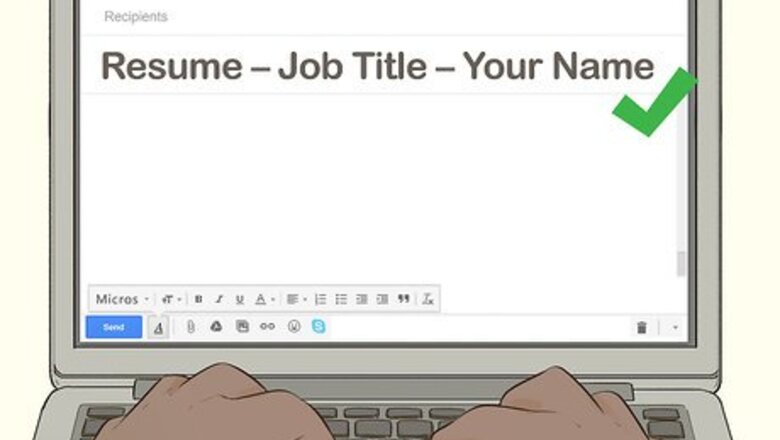
views
X
Research source
- Check for employer instructions first. Otherwise, list your name and the position you’re applying for, and separate elements with hyphens or colons.
- Research the email recipient and mention any common connections with them. Add your top qualification for the job before proofreading carefully.
- Address the email to a specific name if possible. Explain why you’re writing, your interest in the job, details that aren’t in the cover letter, and that your CV is attached.
Including Necessary Information
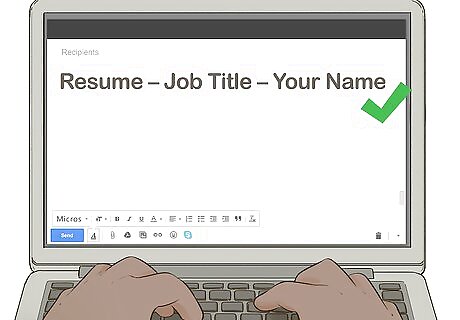
Check for any instructions from the employer. The employer may want specific information in the subject line of your email. If the job listing includes instructions for what to include in the subject line, follow those instructions rather than creating a subject line from scratch. Often employers provide a specific formula for the subject line because they have programmed email filters to catch emails from people applying for a specific job. If you don't follow the employer's formula, your email may be overlooked.
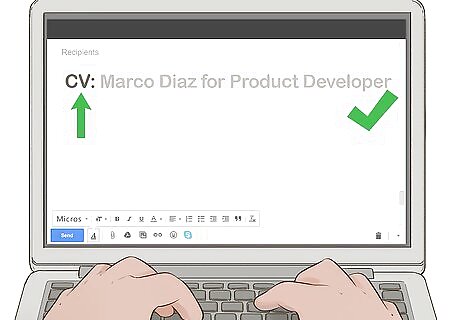
List your name and the position you're applying for. Start your subject line with the word "résumé" or "CV." Then check the job listing to get the exact name the employer uses for the position, including any identification numbers. Type your first and last name as the last element of your subject line. Copy the specific job title, rather than using a generic description such as "entry-level position" or "manager." Use your full first and last name in the subject line. Nicknames or shortened names are not appropriate at this stage. If you have an interview, you can let the recipient know what you prefer to be called.

Separate elements with hyphens or colons. Minimal punctuation keeps your subject line neat and easy to read. Avoid using more than one type of punctuation if at all possible. Make the parts of your subject line flow in a logical way. For example, you might use "CV – Product Developer – Marco Diaz." Another subject line format that works is "CV: Marco Diaz for Product Developer." You can also flip these elements around and write "Marco Diaz CV: Product Developer."Tip: Try to keep your subject line brief. If the recipient views the email on a smartphone or other mobile device, they'll typically only see the first 25 or 30 characters.
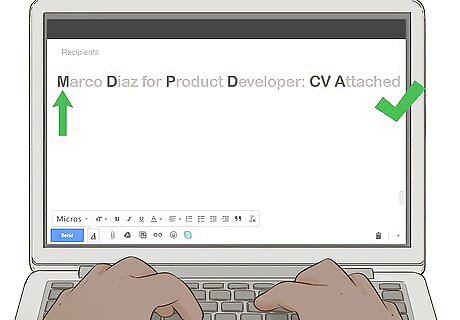
Type your subject line in title case. Using all caps in your subject line may seem like a good way to get the recipient's attention, but it's seen as shouting and sends a bad impression. Capitalize all nouns and verbs in your subject line, and put anything else in lower-case. For example, you might use "Marco Diaz for Product Developer: CV Attached."
Polishing Your Subject Line
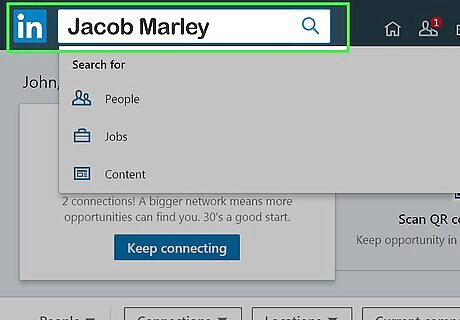
Research the recipient of the email. If you know the name of the recipient, search them online and get information on their background and professional experience. You may find ways that you can make your subject line stand out by appealing to them directly. If the recipient has a LinkedIn account, this can be a good place to find information on their professional background. Reading any articles the recipient has written will also help you prepare for the interview or give you information to add in a follow-up email.

Include a common connection, if possible. If you know someone who works for that employer, or if someone recommended you apply for the job, mention their name in your subject line. This will help you stand out from other applicants. For example, you might use "CV Recommended by Star Butterfly: Marco Diaz for Product Developer." If someone recommended you for the position, put that information at the beginning of the subject line. You want it to be the first thing the recipient reads.Variation: Common connections aren't always people; they can be places too. If you went to the same school as the recipient or interned with the same company, you might include that as well.

Add your top qualification for the position. Generally, you want to keep your subject line brief. However, if there's something special about your background or experience that makes you uniquely qualified for the position, briefly point it out in the subject line. For example, you might write "CV: Marco Diaz for Product Developer, 20 Years Experience."
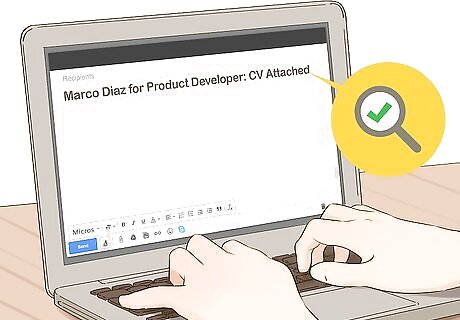
Proofread your subject line carefully. While you may already know to proofread your email, the subject line often gets overlooked. This can be a serious mistake because the subject line is the first (maybe only) thing the recipient will see. Make sure there are no spelling mistakes or typos. Double-check proper names – even your own – to make sure they're spelled correctly.
Putting Together Your Email
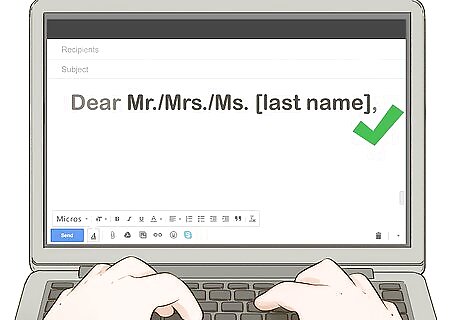
Use a specific name if possible. Check the job listing or the company's website to see if there's a specific person you're submitting your résumé or CV to. If you can't find a specific name, leave the name off entirely and start your email with a basic greeting, such as "Hello." Traditional letter-writing salutations can seem stiff and overly formal in emails. Instead of typing "Dear Mr. Marley," try "Hello Jacob Marley."

Explain briefly why you're writing. Start your email with a sentence clearly stating that you are applying for the job title you listed in your subject line. If applicable, let the person know where you saw the job listed. If someone recommended you for the position, include that in your first sentence as well. For example, you might write "I am applying for the position of Product Designer, which I saw posted on my university's job board."
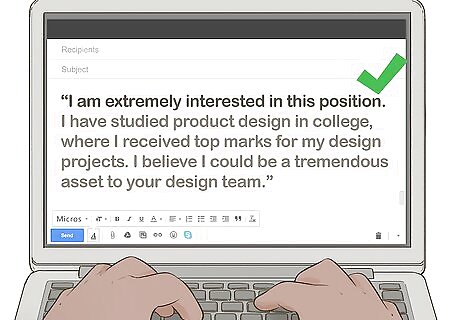
Summarize your interest in the position. Include a brief statement that lets the person know why that particular opportunity caught your eye, or why you would be interested in working for that company. You might also mention any skills or background that make you an excellent candidate for the position. For example, you might write "I am extremely interested in this position. I have studied product design in college, where I received top marks for my design projects. I believe I could be a tremendous asset to your design team."
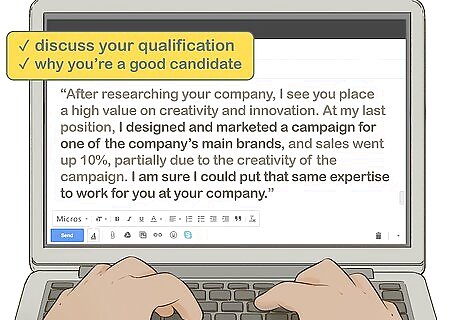
Include more detail if you're not attaching a formal cover letter. If the job listing requests a résumé or CV and cover letter, write a separate cover letter and attach it to the email along with your résumé or CV. However, if the job listing doesn't specify a cover letter, you may want to include the same sort of information in your email that you would in a formal cover letter. Follow the same guidelines you would if writing a cover letter to print on paper. Try to keep the full letter to under a page, using active, direct language to describe your skills and experience. Keep in mind that the recipient may be reading your email on a computer, or on a mobile phone or other mobile device. Use short paragraphs of 3 to 4 words to make your email easier to skim.
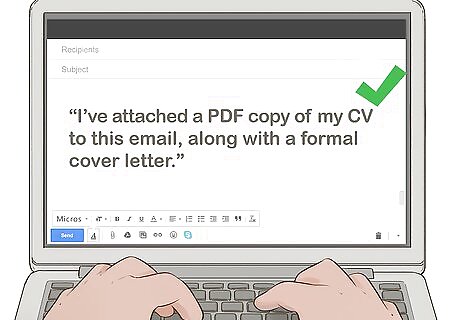
Mention that your résumé or CV is attached. Towards the end of your email, let the recipient know that you have attached your résumé or CV (and formal cover letter, if appropriate). You may also want to mention the file format you used. For example, you might write "I've attached a PDF copy of my CV to this email, along with a formal cover letter."
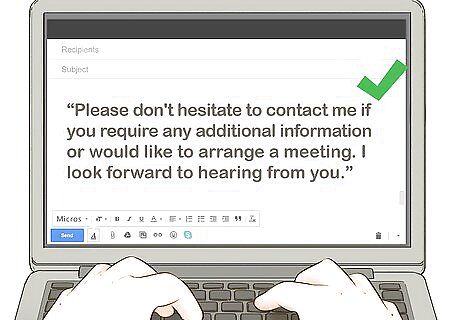
Ask the recipient to contact you if they have any questions. In the last portion of your email, encourage the recipient to contact you and express how grateful you are for the opportunity. You might also note that you look forward to hearing from them or answering any questions they might have. For example, you might write "Please don't hesitate to contact me if you require any additional information or would like to arrange a meeting. I look forward to hearing from you." You might also say that you plan to follow up in a week if you don't hear from them. If you include this in your email, make sure to set yourself a reminder so that you remember to do what you said.Variation: If you're feeling confident, try changing the "if" to "when." This removes some of the uncertainty. For example, you might write "Please don't hesitate to contact me when you're ready to schedule an interview."
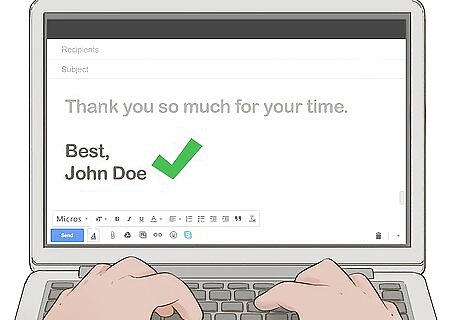
Close with your full name and contact information. Choose a basic letter closing, such as "Sincerely" or "Best," double space below it, then type your first and last name. Below your name, include your phone number. If you have a website, you might include the URL for that as well. Only do this if it's related in some way to the job you're applying for or demonstrates background and skills that are related to the position. If you've formatted a signature for your emails that is automatically applied, there's no need to type your name and contact information.

Convert your résumé or CV into a common file format. Some employers specify what file format you should use. If nothing is mentioned in the job listing, use a .doc or .pdf file. You can also use a .rtf file, although some of your formatting may be lost with that file type. PDF is typically the best format to use for your résumé or CV because the contents of the file can't be accidentally changed or deleted. If you're also sending a formal cover letter, attach it as a separate document in the same file format as your résumé or CV. Save the file with a unique name that includes your first and last name. For example, you might use "Hamilton Alexander Resume.pdf."Tip: Avoid using spaces or special characters in your file name. They aren't accepted by all operating systems, and may impede the recipient's ability to open the file.


















Comments
0 comment